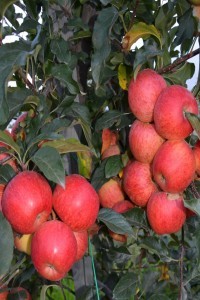The effects of seaweed extracts and the applications of vermiwash on organic lettuce (Lactuva sativa L.) seedlings
The effects of seaweed extracts and the applications of vermiwash on organic lettuce (Lactuva sativa L.) seedlings
In this study, it is aimed to enhance organic seedling cultivation to levels at which it can compete with its conventional counterparts both in quality and growth process of the seedling. To this end, seaweed (SW) and vermiwash (V) were employed in the trial as well as their various doses and blends. 16 different doses and blends including the control group each of which were allocated three seedlings were conducted based on the triplicate principal. At the end of the process, the dry weight of the plants’ root, stem and leaves was identified. The rise in the dry weight of the root, stem and the leaves resulting from the raised doses of seaweed and vermiwash in individual practices has revealed the positive and direct outcomes of the fertilizers on the plant growth. Much as seaweed provided the lowest leaf weight ratio (LWR), it yields the highest LWR. The lowest root weight ratio (RWR) is 0.1671 in SW2 application, whereas the highest leaf weight is 0.8329 in SW2. As a result of the trials, SW3 application shines out on the basis of the total dry weight (0.3125 g) of the lettuce seedlings. In study highest quality index of seedlings (QI) was determined in SW3 applications (0.1787). With respect to the LWR properties, being an important criterion for the lettuce itself and the dry matter for the seedling quality, seaweed applications have been concluded to be advisable
___
- Ahmed, Y., & Shalaby, E. (2012). Effect of different seaweed extracts and compost on vegetative growth, yield and fruit quality of cucumber. J. Hortic. Sci. Orna. Plants, 4(3), 235-240.
- Akyurt, İ., Şahin, Y., & Hasan, K. (2011). Deniz marulunun (Ulva sp.) sıvı organik gübre olarak değerlendirilmesi. Karadeniz Fen Bilimleri Dergisi, 2(2), 55-62.
- Anonymous. (2020). Tarım işletmeleri genel müdürlüğü tohumculuk sektör politika belgesi 2018-2022. Retrieved from http://www.tigem.gov.tr
- Arancon, N.Q., Edwards, C. A., Lee, S., & Byrne, R. (2006). Effects of Humic Acids from Vermicomposts on Plant Growth. European Journal of Soil Biology, 42, 65-69.
- Chanthini, K. M.-P., Senthil-Nathan, S., Stanley-Raja, V., Thanigaivel, A., Karthi, S., Sivanesh, H., & Soranam, R. (2019). Chaetomorpha Antennina (Bory) Kützing Derived Seaweed Liquid Fertilizers as Prospective Bio-Stimulant for Lycopersicon Esculentum (Mill). Biocatalysis and Agricultural Biotechnology, 20, 101190.
- Demir, N., Dural, B., & Yıldırım, K. (2006). Effect of Seaweed Suspensions on Seed Germination of Tomato, Pepper and Aubergine. J Biol Sci, 6(6), 1130-1133.
- Demirsoy, M., & Uzun, S. (2019). The Quantitative Effects of Different Growing Media on the Growth of Aubergine (Solanum melongena L.) and Cucumber (Cucumis sativus L.) in Autumn. International Journal of Environmental Trends (IJENT). 3(2), 151-158.
- Demirtaş, E.I., Özkan, C.F., Asri, F. Ö., & Nuri, A. (2012). Bazı Organik ve Kimyasal Gübre Uygulamalarının Domateste Verim ve Kalite Üzerine Etkileri. Alatarım, 11(2), 9-16.
- Dickson, A., Leaf, A.L., & Hosner, J.F. (1960). Quality appraisal of white spruce and white pine seedling stock in nurseries. The Forestry Chronicle, 36(1), 10-13.
- Duan, E. (2013). Bazı Deniz Makro alglerinden (Ulva sp., Cystoseira sp. ve Corallina sp.) Fermente Sıvı Organik Gübre Üretimi ve Taze Fasülye (Phaseolus vulgaris) Verimine Etkisinin Belirlenmesi. (Yüksek Lisans), Giresun Üniversitesi, Giresun. (380607)
- Godlewska, K., Michalak, I., Tuhy, L., & Chojnacka, K. (2016). Plant growth biostimulants based on different methods of seaweed extraction with water. BioMed research international, 2016, 1-11.
- Gutiérrez-Miceli, F.A., Santiago-Borraz, J., Molina, J.A.M., Nafate, C.C., Abud-Archila, M., Llaven, M.A.O., & Dendooven, L. (2007). Vermicompost as a soil supplement to improve growth, yield and fruit quality of tomato (Lycopersicum esculentum). Bioresource Technology, 98(15), 2781-2786.
- Hameeda, B., Harini, G., Rupela, O., & Reddy, G. (2007). Effect of composts or vermicomposts on sorghum growth and mycorrhizal colonization. African Journal of Biotechnology, 6(1), 009-012.
- Kandemir, D., Kurtar, E. S., & Demirsoy, M. (2017). Türkiye örtüaltı domates yetiştiriciliğindeki gelişmeler. Türktob Türkiye Tohumcular Birliği Dergisi, 17, 22-27.
- Mzibra, A., Aasfar, A., El Arroussi, H., Khouloud, M., Dhiba, D., Kadmiri, I. M., & Bamouh, A. (2018). Polysaccharides extracted from moroccan seaweed: a promising source of tomato plant growth promoters. Journal of Applied Phycology, 30(5), 2953-2962.
- Özer, H., & Kandemir, D. (2016). Evaluation of the performance of greenhouse tomato seedlings grown with different cultivation techniques. Bangladesh Journal of Botany, 45(1), 203-209.
- Öztekin, G.B., & Kevser, T. (2019). tam spektrumlu gün ışığı floresan lamba ile yapay ışıklandırmanın marulda fide kalitesine etkisi. Ege Üniversitesi Ziraat Fakültesi Dergisi, 56(4), 437-445.
- Sarıbaş, H. Ş., Saka, A.K., & Özer, H. (2018). Mathematical growth model for organically grown pepper transplants. Biological Agriculture & Horticulture, 34(1), 10-17. TUİK. (2020). Turkish Statistical Institute Statistical Data (https://biruni.tuik.gov.tr /medas/?kn=92&locale=tr,).
- Türkmen, M., & Su, A. (2019). The effect of sea lettuce (Ulva lactuca) liquid fertilizer and zeolite combinations on the development of cucumber (Cucumis sativus). Turkish Journal of Agriculture-Food Science and Technology, 7(7), 1021-1027.
- Uzun, S. (1996). The Quantitative Effects of Temperature and Light Environment on the Growth, Development and Yield of Tomato (Lysopersicon Esculentum, Mill) and Aubergine (Solanum Melongena L.). University of Reading, England.
- Yanmaz, R., Balkaya, A., Akan, S., Kaymak, H. Ç., Sarıkamış, G., Önal Ulukapı, K., &Açıkgöz, F. E. (2020). Sebzecilik Sektörü: Dünü, Bugünü ve Geleceği. Türkiye Ziraat Mühendisliği IX. Teknik Kongresi, Ankara. s595-607.
- Yayın Aralığı: Yılda 2 Sayı
- Başlangıç: 2019
- Yayıncı: Burhan ÖZTÜRK
